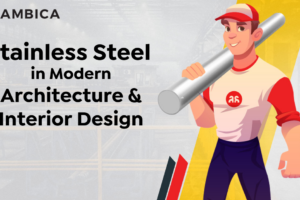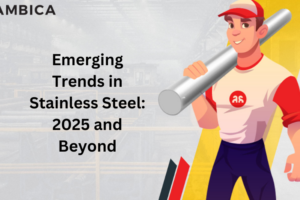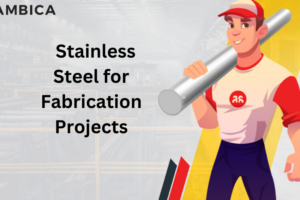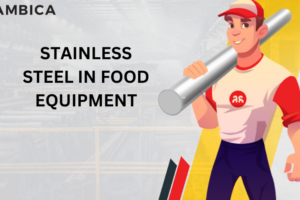Steel is an integral, classified, and essential material in the evolution of the industrial world. Varying from Carbon steel to Stainless Steel, numerous types and grades are procured around the globe. Mild Steel is amongst one of a wide range. Iron is alloyed with carbon to form Mild Steel.
Chemical Composition
Mild Steel is basically low carbon steel. It contains approximately 0.05% to 0.25% of carbon by weight. Basically, it is not alloy steel and does not contain chromium, molybdenum, or another alloying element. Its chemical composition differentiates its properties from alloy steels.
Physical Properties
Mild steel is ductile, machinable, and weldable. It can easily cut, machined, and formed into various industrial oriented shapes. Mild steels are not subjected to get strengthened from heat treatment. The absence of alloying elements makes it more prone to corrosion.
How is Mild Steel made?
Mild steel formation involves a combination of iron ore and coal in the presence of lime and melted together in a blast furnace. Molten iron is then formed. Molten iron contains impurities, and is needed to exterminate. Basic Oxygen Steel (BOS) and Electric Arc Furnace (EAF) are the two common alternate methods to burn off impurities. This step is called Primary Steel Making. Then the Secondary Steelmaking process comes into action in which adjustments are made to achieve mild steel’s chemical composition. Following that, steel is cast to solidify into desired shapes. The mild steel slabs are shaped into different products by using hot rolling or cold drawing.
APPLICATIONS OF MILD STEEL
Carbon steel are positioned as the leading element of steel production. Mild steel has some impressive properties like high tensile strength and impact strength. Mild steel is widely used in a variety of industries. It is the most common type of steel used all around.
Some common applications are as follows:
- Construction – Mild steel is used extensively for construction, as it advantageous weldability and machinability. It can withstand impact loads and is broadly used in construction, like buildings and bridges.
- Machinery applications – like automobile manufacturing. It is readily accessible to cutting and welding.
- Knives – Carbon steel knives stay sharper for a longer time and easier to sharpen. Professional chefs have a preference for high carbon steel knives as they required a lot of precision knife work in the kitchen.
- Fencing- Mild steel can be adept into different shapes and provides a visual appeal.
- Pipelines, Poles, wire, and nails are commonly manufactured by using mild steel.
Difference between Stainless Steel and Mild Steel
Steel is the phenomenal term that constitutes a huge variety of metal products. Stainless steel and mild steel can clearly be distinguished, so as their applications.
Alloying element
This is the main characteristic to determine the factor. Stainless Steel has chromium, nickel, and molybdenum as an alloying element, whereas Mild Steel is alloyed with carbon. This basic composition is responsible for creating the difference in corrosion resistance, weldability, cost, applications, etc.
Corrosion-Resistant
Chromium is the alloying element in stainless steel and reacts with oxygen in the atmosphere to form a protective layer called chromium oxide. This layer provides considerable corrosion resistance. On the contrary, Mild Steel does not have chromium. Iron content in Mild steel reacts with moisture in the air and form iron oxide, which is basically rust. Stainless Steel provides considerable resistance towards corrosion, whereas Mild steel does not, it requires further coating preventing rust. Stainless steel is more strengthen than Mild steel.
Hardness
Stainless Steel exhibits more hardness than mild steel, as Stainless steel contains chromium and nickel.
Ductility
Ductility is the ability to undergo deformation with cracking. Mild steel has low carbon content, and it is more ductile than stainless steel.
Weldability
Mild steel is more weldable than stainless steel.
Magnetization
Mild steel shows permanent magnetization as iron content is more. Conversely, stainless steel does not characterize by the presence of a magnetic field.
Fabrication
It is easy to cut or bent the Mild steel whereas to fabricate stainless steel, machinery and technique are necessary.
Aesthetics
Stainless steel has more shiny and visual appeal than mild steel.
Cleaning and Maintenance
Stainless steel requires less maintenance than mild steel
Applications
Mild steel is extensively used in construction and automobile. Due to corrosion resistance ability, Stainless steel widely uses in commercial food processing equipment, chemical storage, and manufacturing, surgical equipment, marine use, etc.
Life span
Existence duration is more for stainless steel, as mild steel gets corrode easily without proper maintenance.
Cost
The cost is a noteworthy concern when it comes to choosing between stainless steel and mild steel. The alloying elements, manufacturing process, and skilled workers are workings requisite for producing stainless steel. On the counterpart, Mild steel is an economical metal.
To conclude, Stainless steel and mild steel exhibits distinctive matchless qualities. The type of steel to decide depends on comprehensive needs. At Ambica Steels, our expert engineering solution group is always ready for inquiries and consultations.




